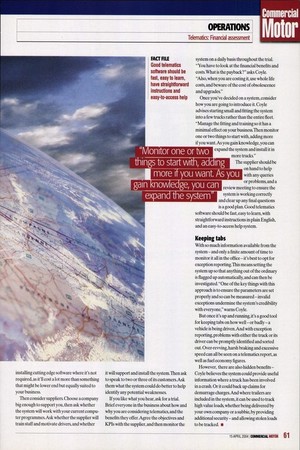CHEAP
Page 58

Page 59

If you've noticed an error in this article please click here to report it so we can fix it.
AS CHIPS
Are telematics just an expensive toy? Or could you use them to help cut your fleet's running
costs? Emma Penny investigates.
Today's telematics systems cost half what they did five years ago and given the speed of computing development, they're capable of more than twice as much.
Roughly 100 firms are offering you their version of the perfect system—but is there really any advantage in spending your hard earned cash on more computer gadgetry?
One man who believes telematics can play a vital role in businesses — if they are used correctly —is fuel economy specialist Dr Michael Coyle. Because telematics systems collect and display vehicle and driver-related information about what has happened or is happening now, it means you can keep track of your fleet at all times. Coyle also believes they have a vital role in helping fleets manage fuel costs.
He says companies using the systems correctly should benefit from lower fuel consumption, elimination of off-route mileage and cheaper insurance, as well as reduced communication costs, paperwork and errors. Cost savings Companies that have invested in the technology are seeing benefits, says Coyle. In trials, Glanbia Foods identified a potential £200,000 saving a year by being able to manage and quickly switch routes, as well as finding that its drivers performed better.Tesco trials showed
a potential fuel saving of 4-5%, equating to a saving of about £2m a year.
So telematics do work — but how do you go about introducing them into your fleet, and working out which of the 100 or so suppliers you should choose? Don't be over-ambitious
Before even considering suppliers, Coyle warns that because so much information can be collected, it is easy to be overwhelmed by it all and actually end up not using the system at all — or only to a very limited extent. He says he's even heard of companies removing systems because they just can't cope with them. Think about what the essential pieces of data are first, he advises. What's the bare minimum you need the system to do? Then consider what you'd like it to do.Ask people within your business who'll be involved with the system what they need or would like.Among the possibilities are vehicle and driver data; vehicle tracking; trailer tracking; text messaging; paperless manifests and POD; traffic information; and on-board navigation. Not all of them will be useful, so there's little point in paying for them. He also warns against
installing cutting edge software where it's not required, as it'll cost a lot more than something that might be lower end but equally suited to your business. Then consider suppliers. Choose a company big enough to support you, then ask whether the system will work with your current computer programmes. Ask whether the supplier will train staff and motivate drivers, and whether
it will support and install the system.Then ask to speak to two or three of its customers.Ask them what the system could do better to help identify any potential weaknesses. If you like what you hear, ask for a trial. Brief everyone in the business about how and why you are considering telematics, and the benefits they offer.Agree the objectives and KPIs with the supplier, and then monitor the
system on a daily basis throughout the trial. "You have to look at the financial benefits and
costs. What is the payback?" asks Coyle. "Also, when you are costing it, use whole life costs, and beware of the cost of obsolescence
and upgrades." Once you've decided on a system, consider how you are going to introduce it. Coyle advises starting small and fitting the system into a few trucks rather than the entire fleet. "Manage the fitting and training so it has a minimal effect on your business.Then monitor one or two things to start with, adding more if you want, As you gain knowledge, you can expand the system and install it in
more trucks." The supplier should be on hand to with any queries or problems, and review meeting to ensure system is working correctly and clear up any final questions
is a good plan. Good telematics software should be fast, easy to learn, with straightforward instructions in plain English, and an easy-to-access help system. Keeping tabs
With so much information available from the system— and only a finite amount of time to monitor it all in the office —it's best to opt for exception reporting.This means setting the system up so that anything out of the ordinary is flagged up automatically, and can then be investigated."One of the key things with this approach is to ensure the parameters are set properly and so can be measured — invalid exceptions undermine the system's credibility with everyone," warns Coyle.
But once it's up and running, it's a good tool for keeping tabs on how well — or badly — a vehicle is being driven. And with exception reporting, problems with either the truck or its driver can be promptly identified and sorted out. Over-revving, harsh braking and excessive speed can all be seen on a telematics report, as well as fuel economy figures. However, there are also hidden benefits — Coyle believes the system could provide useful information where a truck has been involved in a crash. Or it could back up claims for demurrage charges.And where trailers are included in the system, it can be used to track high value loads, whether being delivered by your own company or a subbie, by providing additional security—and allowing stolen loads to be tracked. •
























































































































































































